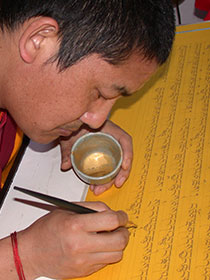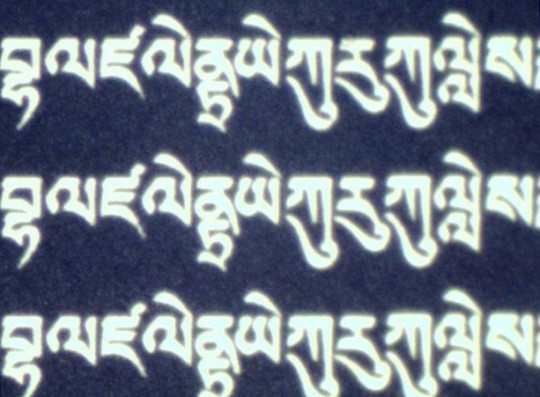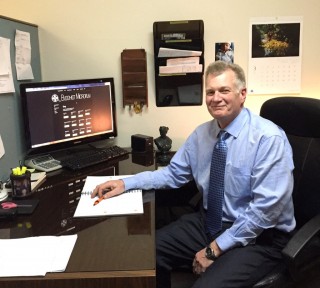- Home
- FPMT Homepage
Foundation for the Preservation of the Mahayana Tradition
The FPMT is an organization devoted to preserving and spreading Mahayana Buddhism worldwide by creating opportunities to listen, reflect, meditate, practice and actualize the unmistaken teachings of the Buddha and based on that experience spreading the Dharma to sentient beings. We provide integrated education through which people’s minds and hearts can be transformed into their highest potential for the benefit of others, inspired by an attitude of universal responsibility and service. We are committed to creating harmonious environments and helping all beings develop their full potential of infinite wisdom and compassion. Our organization is based on the Buddhist tradition of Lama Tsongkhapa of Tibet as taught to us by our founders Lama Thubten Yeshe and Lama Thubten Zopa Rinpoche.
- Willkommen
Die Stiftung zur Erhaltung der Mahayana Tradition (FPMT) ist eine Organisation, die sich weltweit für die Erhaltung und Verbreitung des Mahayana-Buddhismus einsetzt, indem sie Möglichkeiten schafft, den makellosen Lehren des Buddha zuzuhören, über sie zur reflektieren und zu meditieren und auf der Grundlage dieser Erfahrung das Dharma unter den Lebewesen zu verbreiten.
Wir bieten integrierte Schulungswege an, durch denen der Geist und das Herz der Menschen in ihr höchstes Potential verwandelt werden zum Wohl der anderen – inspiriert durch eine Haltung der universellen Verantwortung und dem Wunsch zu dienen. Wir haben uns verpflichtet, harmonische Umgebungen zu schaffen und allen Wesen zu helfen, ihr volles Potenzial unendlicher Weisheit und grenzenlosen Mitgefühls zu verwirklichen.
Unsere Organisation basiert auf der buddhistischen Tradition von Lama Tsongkhapa von Tibet, so wie sie uns von unseren Gründern Lama Thubten Yeshe und Lama Thubten Zopa Rinpoche gelehrt wird.
- Bienvenidos
La Fundación para la preservación de la tradición Mahayana (FPMT) es una organización que se dedica a preservar y difundir el budismo Mahayana en todo el mundo, creando oportunidades para escuchar, reflexionar, meditar, practicar y actualizar las enseñanzas inconfundibles de Buda y en base a esa experiencia difundir el Dharma a los seres.
Proporcionamos una educación integrada a través de la cual las mentes y los corazones de las personas se pueden transformar en su mayor potencial para el beneficio de los demás, inspirados por una actitud de responsabilidad y servicio universales. Estamos comprometidos a crear ambientes armoniosos y ayudar a todos los seres a desarrollar todo su potencial de infinita sabiduría y compasión.
Nuestra organización se basa en la tradición budista de Lama Tsongkhapa del Tíbet como nos lo enseñaron nuestros fundadores Lama Thubten Yeshe y Lama Zopa Rinpoche.
A continuación puede ver una lista de los centros y sus páginas web en su lengua preferida.
- Bienvenue
L’organisation de la FPMT a pour vocation la préservation et la diffusion du bouddhisme du mahayana dans le monde entier. Elle offre l’opportunité d’écouter, de réfléchir, de méditer, de pratiquer et de réaliser les enseignements excellents du Bouddha, pour ensuite transmettre le Dharma à tous les êtres. Nous proposons une formation intégrée grâce à laquelle le cœur et l’esprit de chacun peuvent accomplir leur potentiel le plus élevé pour le bien d’autrui, inspirés par le sens du service et une responsabilité universelle. Nous nous engageons à créer un environnement harmonieux et à aider tous les êtres à épanouir leur potentiel illimité de compassion et de sagesse. Notre organisation s’appuie sur la tradition guéloukpa de Lama Tsongkhapa du Tibet, telle qu’elle a été enseignée par nos fondateurs Lama Thoubtèn Yéshé et Lama Zopa Rinpoché.
Visitez le site de notre Editions Mahayana pour les traductions, conseils et nouvelles du Bureau international en français.
Voici une liste de centres et de leurs sites dans votre langue préférée
- Benvenuto
L’FPMT è un organizzazione il cui scopo è preservare e diffondere il Buddhismo Mahayana nel mondo, creando occasioni di ascolto, riflessione, meditazione e pratica dei perfetti insegnamenti del Buddha, al fine di attualizzare e diffondere il Dharma fra tutti gli esseri senzienti.
Offriamo un’educazione integrata, che può trasformare la mente e i cuori delle persone nel loro massimo potenziale, per il beneficio di tutti gli esseri, ispirati da un’attitudine di responsabilità universale e di servizio.
Il nostro obiettivo è quello di creare contesti armoniosi e aiutare tutti gli esseri a sviluppare in modo completo le proprie potenzialità di infinita saggezza e compassione.
La nostra organizzazione si basa sulla tradizione buddhista di Lama Tsongkhapa del Tibet, così come ci è stata insegnata dai nostri fondatori Lama Thubten Yeshe e Lama Zopa Rinpoche.
Di seguito potete trovare un elenco dei centri e dei loro siti nella lingua da voi prescelta.
- 欢迎 / 歡迎
简体中文
“护持大乘法脉基金会”( 英文简称:FPMT。全名:Foundation for the Preservation of the Mahayana Tradition) 是一个致力于护持和弘扬大乘佛法的国际佛教组织。我们提供听闻,思维,禅修,修行和实证佛陀无误教法的机会,以便让一切众生都能够享受佛法的指引和滋润。
我们全力创造和谐融洽的环境, 为人们提供解行并重的完整佛法教育,以便启发内在的环宇悲心及责任心,并开发内心所蕴藏的巨大潜能 — 无限的智慧与悲心 — 以便利益和服务一切有情。
FPMT的创办人是图腾耶喜喇嘛和喇嘛梭巴仁波切。我们所修习的是由两位上师所教导的,西藏喀巴大师的佛法传承。
繁體中文
護持大乘法脈基金會”( 英文簡稱:FPMT。全名:Found
ation for the Preservation of the Mahayana Tradition ) 是一個致力於護持和弘揚大乘佛法的國際佛教組織。我們提供聽聞, 思維,禪修,修行和實證佛陀無誤教法的機會,以便讓一切眾生都能 夠享受佛法的指引和滋潤。 我們全力創造和諧融洽的環境,
為人們提供解行並重的完整佛法教育,以便啟發內在的環宇悲心及責 任心,並開發內心所蘊藏的巨大潛能 — 無限的智慧與悲心 – – 以便利益和服務一切有情。 FPMT的創辦人是圖騰耶喜喇嘛和喇嘛梭巴仁波切。
我們所修習的是由兩位上師所教導的,西藏喀巴大師的佛法傳承。 察看道场信息:
- FPMT Homepage
- News/Media
-
- Study & Practice
-
-
- About FPMT Education Services
- Latest News
- Programs
- New to Buddhism?
- Buddhist Mind Science: Activating Your Potential
- Heart Advice for Death and Dying
- Discovering Buddhism
- Living in the Path
- Exploring Buddhism
- FPMT Basic Program
- FPMT Masters Program
- FPMT In-Depth Meditation Training
- Maitripa College
- Lotsawa Rinchen Zangpo Translator Program
- Universal Education for Compassion & Wisdom
- Online Learning Center
-
- Prayers & Practice Materials
- Overview of Prayers & Practices
- Full Catalogue of Prayers & Practice Materials
- Explore Popular Topics
- Benefiting Animals
- Chenrezig Resources
- Death & Dying Resources
- Lama Chopa (Guru Puja)
- Lama Zopa Rinpoche: Compendium of Precious Instructions
- Lama Zopa Rinpoche: Life Practice Advice
- Lama Zopa Rinpoche Practice Series
- Lamrim Resources
- Mantras
- Prayer Book Updates
- Purification Practices
- Sutras
- Thought Transformation (Lojong)
- Audio Materials
- Dharma Dates - Tibetan Calendar
- Translation Services
- Publishing Services
- Ways to Offer Support
- Prayers & Practice Materials
-
- Teachings and Advice
- Find Teachings and Advice
- Lama Zopa Rinpoche Advice Page
- Lama Zopa Rinpoche: Compendium of Precious Instructions
- Lama Zopa Rinpoche Video Teachings
- ༧སྐྱབས་རྗེ་བཟོད་པ་རིན་པོ་ཆེ་མཆོག་ནས་སྩལ་བའི་བཀའ་སློབ་བརྙན་འཕྲིན།
- Podcasts
- Lama Yeshe Wisdom Archive
- Buddhism FAQ
- Dharma for Young People
- Resources on Holy Objects
- Teachings and Advice
-
-
*If a menu item has a submenu clicking once will expand the menu clicking twice will open the page.
-
-
- Centers
-
- Teachers
-
- Projects
-
-
-
-
*If a menu item has a submenu clicking once will expand the menu clicking twice will open the page.
-
-
- FPMT
-
- Shop
-
-
-
The Foundation Store is FPMT’s online shop and features a vast selection of Buddhist study and practice materials written or recommended by our lineage gurus. These items include homestudy programs, prayers and practices in PDF or eBook format, materials for children, and other resources to support practitioners.
Items displayed in the shop are made available for Dharma practice and educational purposes, and never for the purpose of profiting from their sale. Please read FPMT Foundation Store Policy Regarding Dharma Items for more information.
-
-
1
The Inside Story: Microfilm, Holy Objects, and the Passion of Tai Vautier
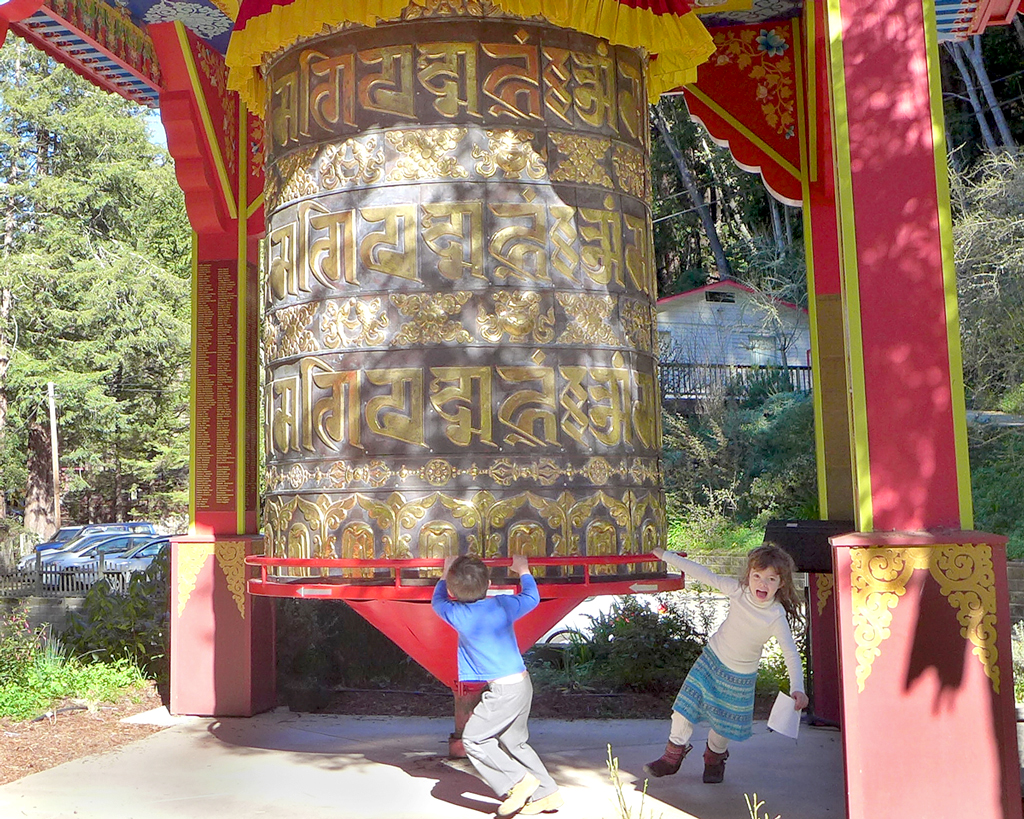
Prayer wheel with 64 billion OM MANI PADME HUM mantras at Land of Medicine Buddha, California, US, January 2015. Photo by Laura Miller.
By Donna Lynn Brown
Who hasn’t spun a prayer wheel? Whether a massive work of art that we propel with our whole bodies, a desktop ornament we twist with our fingertips, a decorated paint can on a spoke or a hand-held cylinder, most of us have set a prayer wheel into motion and hoped for blessings to fly out.
But do we consider precisely what is inside the wheel? Oh, mantras, you say. You know that. But mantras have to be printed on something. In the old days, that was paper. You may assume that’s what is in the wheel you are spinning today, but paper is getting less and less common. It only holds so many mantras, and it deteriorates over time. Perhaps you think it should be replaced by a CD or a flash drive – something digital for the modern world. Would that have the same power to bless? Unfortunately, no. Lama Zopa Rinpoche has explained that mantras in prayer wheels, statues and stupas need to be visible – even if only by microscope. A mantra that cannot be seen by the human eye in any circumstances carries no blessing.
Exit digital. Enter microfilm. Unlike bits and bytes, microfilm bears actual images of mantras. And thanks to microfilm, a large prayer wheel can contain billions of them. Better still, the film can last up to five hundred years. Yet while microfilm may seem outrageously modern compared to ancient mantras, the technology is actually aging and falling out of use. That creates its own challenges.
Tai Vautier knows this better than anyone. Tai, a talented jewelry-maker, was born in Spain to Buddhist parents, raised around FPMT’s Lama Yeshe and Lama Zopa Rinpoche at Vajrapani Institute in California, and currently lives in Oregon in the United States. For years now, she has been working to produce mantra microfilm. The story of its current use in FPMT’s holy objects is largely Tai’s story.
“Back in 2001,” she recalled, “I was given a hand-held prayer wheel by another FPMT student, Julia Hengst. Julia always carried a prayer wheel in those days, and I used to tease her about it. The one she gave me was wood and made by Jim Glass. He’s passed away now, but he used to make these beautiful prayer wheels. I was skeptical, but when I started spinning the wheel, I noticed right away that it wasn’t just a chunk of wood, it was like a ‘being’ – I felt like I was hanging out with a really good person. I got hooked. Then my husband, Robert Woods, and I decided to make them. Jim Glass taught us in his workshop in Berkeley. This was in 2002, when my kids were just born. We stuck to his design and started making them in our garage in Albuquerque, New Mexico. Jim was using microfilm for the mantras. With film, millions and millions of mantras could go into even a small prayer wheel. Julia always stressed how important that was: the sheer number of mantras. Jim had a stock of microfilm with manis (the mantra OM MANI PADME HUM) on it, but the master had been lost.” In the audio-visual world, a master is the original from which copies are made. Without a master for the microfilm manis, there was no way of making more. “So I decided to create a new OM MANI PADME HUM master,” Tai continued. “That’s how I got started.”
It wasn’t easy finding a microfilm producer to work with. Producers hadn’t heard of prayer wheels and wouldn’t give Tai the time of day. Finally, she ran across a Texan in Albuquerque who worked in microfilm – and who had once given his wife a bracelet engraved with OM MANI PADME HUM. When Tai talked about the mantra, he understood. The two of them started working together in 2003. Tai and her husband kept making wooden prayer wheels for about a year, but she wanted to focus on microfilm. They handed the making of the wheels over to long-time friend Chuck Thomas, who also supplies some of the prayer wheels found in the Foundation Store, FPMT’s online shop.
Getting as many mantras as possible on the film, while keeping them legible, was Tai’s aim. At first, using an old Ditto machine, she copied mantras from Lorne Ladner’s book, Wheel of Great Compassion: The Practice of the Prayer Wheel in Tibetan Buddhism, but shrinking made these illegible. She then got the original of one set of Lorne’s mantras, which had come from the office of His Holiness the Dalai Lama. This she scanned and edited in Photoshop. She managed to get an astonishing 880,000,000 manis onto a 2,000-foot (610-meter) roll of microfilm. But although the mantra remained readable, the master, due to the shape of the Tibetan letters, was too fragile to withstand the constant duplication needed to fill large orders. While this master is still available for small jobs, a sturdier one was needed. Tai worked long hours in Photoshop to thicken some parts of the Tibetan letters and spread others apart, in effect designing her own font in order to create mantras that were readable after reduction and didn’t cause the film to weaken with heavy use.
Tai’s Photoshopped images turned out well, but the files had too much data to be sent digitally to a microfilm camera. They had to be printed. Even the best printers bleed when letters are that small. And no matter how smooth the paper was, its grain distorted the tiny letters. Tai persevered. She discovered she could send her images digitally to a machine that used a highly sensitive photomultiplier tube. With this, a page of miniature mantras could, like a photo, be developed and printed on completely smooth 11” x 14” (28 cm x 36 cm) paper. This was photographed and printed onto a 5/8” (16 mm) frame of microfilm. Each mantra, at this point, was no larger than the tip of a hair and visible only by microscope.
Just how small could they go? In her passion for numbers, Tai worried that she might be shrinking the mantras too much. She consulted Lama Zopa Rinpoche. Size didn’t matter, he said, as long as the mantras remained perfectly clear under magnification. To improve quality, she upsized the mantras slightly, going from “super high-density” to “high-density.” A 2,000-foot (610-meter) high-density roll of microfilm now holds 685,809,230 mani mantras. Over the years, she made a total of 18 such high-density masters for various mantras requested by different Dharma groups, each one taking months of painstaking labor to complete.
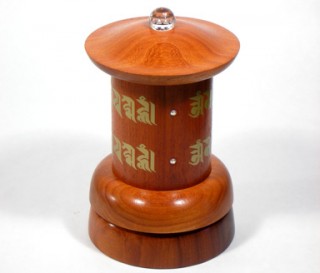
Prayer wheel made by FPMT student Chuck Thomas for the Foundation Store, FPMT International Office’s online shop
Tai achieved her goal of putting vast numbers of crystal-clear mantras onto microfilm, and Dharma centers have purchased more than a million dollars worth of high-density film made from her masters. The film is in hundreds of prayer wheels and other holy objects around the world. For Tai, it was a labor of love, and all done as a volunteer. She said, smiling, “I was just happy to help people make mantras. Because of having had my own prayer wheel for a while, I could see how important they were. But after making 18 master rolls, I did need a rest!”
While Tai refocused her life on family and jewelry-making, the company she had worked with to print the microfilm rolls went through ownership changes. Eventually about 50 master rolls of mantras, prayers, and PDFs of sutras made by Tai, FPMT, prayer wheel makers, and others were in company’s hands. But over time, the master rolls, some in good condition and some deteriorating with use, were moved to a different city and a company where Tai no longer had a contact. And although Lama Zopa Rinpoche had asked Tai to keep an eye on quality, the changes in ownership and location made this impossible. In 2014, orders started to back up, shipments fell to nothing, and phone calls to the company went unreturned. Worse, the master rolls were nowhere to be found. Tai started getting calls. Was she willing to plunge back into the microfilm project?
Tai didn’t hesitate. She contacted the company, and, after some back and forth, managed to get most of the masters back. Missing was the one most heavily used – the mani roll. As fortune would have it, Tom Truty, FPMT’s director of Education Services, had a second master of that one at FPMT’s International Office in Portland – a back-up wisely archived years earlier. With the help of FPMT as well as translator-scholar Eric Fry-Miller, Tai inspected the master rolls for quality. Some had broken down, but about 30 remained in good enough condition to be put back into use.
She took on yet another challenge: finding a new producer in a world where few printers still work with microfilm. Luck was on her side. Practically on her doorstep, Tai found Jeff Lindquist and his company Linco Micro-Image Systems, of Clackamas, Oregon. Jeff grew up around microfilm – his father was in the business – but was considering getting out in favor of digital. When Tai talked to him, he changed his mind.
“I have a passion for microfilm, so I’m fascinated to see it being used in this unique way,” said Jeff. “I’ve been reading Lorne Ladner’s book because I want to learn everything about this so we can do it perfectly. We’ve invested in a new camera to get the best clarity – with such small images, precision is vital. And quality is our main goal. We’re also looking for a second duplicator to make sure we can meet the demand, and I plan to hire one or two new people once everything gets going. It’s exciting.” Jeff is already filling orders – and Tai is delighted with his commitment to quality and understanding of the details.
And, working with Tom Truty, Tai and Jeff are taking steps to make microfilm easier to order and use.
First, they relabeled each master roll in both English and Tibetan, with labels that show direction as well as name, and can be read without magnification. This helps users to know what is on the film, install it upright, and ensure it revolves in the correct direction, a priority of Lama Zopa Rinpoche. Labels have been inserted every 100 feet (30 meters), so if a film gets broken, the pieces can still be identified.
“Relabeling is something I’ve wanted to do for a while,” Tai explained. “I get complaints from prayer wheel makers about how hard it is to know which film they are using or its direction, since the mantras can only be read with a scientific microscope. And then the microscope flips the image, making it even more complicated to figure out which way it’s going. Now, every single roll has a clear indicator that can be seen with the naked eye. Jeff and I spent weeks on this, but it’s worth it!”
Second, with the collaboration of Eric Fry-Miller, Tai has been helping Jeff to create a website – buddhistmicrofilm.com – so customers can order on-line from a list of what’s available. Jeff also plans to keep a stock of popular mantras on hand for quick delivery. And for those needing to put a new mantra or text on microfilm, he will make PDF-style masters on request. The website will also list makers of prayer wheels.
FPMT is helping too. Even though others will be able to order copies of FPMT’s masters from Linco, Tom Truty has made clear that FPMT will not collect royalties – a practical way to keep prices low, and one in keeping with a karma-based approach to spiritual products.
Will Tai make more high-density masters? Existing ones will eventually erode and need replacing, but using the old photomultiplier technology is probably no longer feasible. Making PDFs of pages, or typing then shrinking mantras digitally, are solutions that produce fewer mantras, but allow masters to be created more easily. But Tai hasn’t abandoned the dream of high-density. “I’m checking it out,” she said. “Jeff has access to a newer technology that may be able to create high-density masters without the time or expense of the old process. We are making test runs and it looks hopeful.” She smiled as she explained. “I still want prayer wheels to have billions of mantras!”
Tai was thrilled to hear that the new arrangements for microfilm have received a final stamp of approval. “Lama Zopa Rinpoche himself has ordered the first new master roll to be made by Linco. It includes the five powerful mantras, the four Dharmakaya Relic mantras, Avalokiteshvara and others. And anyone will be able to order it. So we are really honored!”
It’s a fitting tribute to Tai’s efforts to fill the universe with billions of blessings.
More information on mantra microfilm, including ways to order it for stupas and statues is made available by FPMT Education Services on FPMT.org.
Prayer wheels of different kinds and sizes are available through the Foundation Store, FPMT International Office’s online shop. All proceeds from the Foundation Store are used to further the charitable mission of FPMT, Inc.
Donna Lynn Brown is a regular Mandala contributor and a student at Maitripa College in Portland, Oregon, US.
- Home
- News/Media
- Study & Practice
- About FPMT Education Services
- Latest News
- Programs
- New to Buddhism?
- Buddhist Mind Science: Activating Your Potential
- Heart Advice for Death and Dying
- Discovering Buddhism
- Living in the Path
- Exploring Buddhism
- FPMT Basic Program
- FPMT Masters Program
- FPMT In-Depth Meditation Training
- Maitripa College
- Lotsawa Rinchen Zangpo Translator Program
- Universal Education for Compassion & Wisdom
- Online Learning Center
- Prayers & Practice Materials
- Overview of Prayers & Practices
- Full Catalogue of Prayers & Practice Materials
- Explore Popular Topics
- Benefiting Animals
- Chenrezig Resources
- Death & Dying Resources
- Lama Chopa (Guru Puja)
- Lama Zopa Rinpoche: Compendium of Precious Instructions
- Lama Zopa Rinpoche: Life Practice Advice
- Lama Zopa Rinpoche Practice Series
- Lamrim Resources
- Mantras
- Prayer Book Updates
- Purification Practices
- Sutras
- Thought Transformation (Lojong)
- Audio Materials
- Dharma Dates – Tibetan Calendar
- Translation Services
- Publishing Services
- Teachings and Advice
- Find Teachings and Advice
- Lama Zopa Rinpoche Advice Page
- Lama Zopa Rinpoche: Compendium of Precious Instructions
- Lama Zopa Rinpoche Video Teachings
- ༧སྐྱབས་རྗེ་བཟོད་པ་རིན་པོ་ཆེ་མཆོག་ནས་སྩལ་བའི་བཀའ་སློབ་བརྙན་འཕྲིན།
- Podcasts
- Lama Yeshe Wisdom Archive
- Buddhism FAQ
- Dharma for Young People
- Resources on Holy Objects
- Ways to Offer Support
- Centers
- Affiliates Area
- Teachers
- Projects
- Charitable Projects
- Make a Donation
- Applying for Grants
- News about Projects
- Other Projects within FPMT
- Support International Office
- Projects Photo Galleries
- Give Where Most Needed
- FPMT
- Shop
Translate*
*powered by Google TranslateTranslation of pages on fpmt.org is performed by Google Translate, a third party service which FPMT has no control over. The service provides automated computer translations that are only an approximation of the websites' original content. The translations should not be considered exact and only used as a rough guide.The reason we are unhappy is because we have extreme craving for sense objects – samsaric objects – and we grasp at them. We are seeking to solve our problems, but we are not seeking in the right place. The right place is our ego-grasping.







